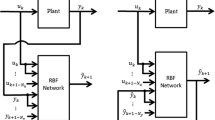Abstract
One of the main problems associated with artificial neural networks on-line learning methods is the estimation of model order. In this paper, we report about a new approach to constructing a resource-allocating radial basis function network exploiting weights adaptation using recursive least-squares technique based on Givens QR decomposition. Further, we study the performance of pruning strategy we introduced to obtain the same prediction accuracy of the network with lower model order. The proposed methods were tested on the task of Mackey-Glass time-series prediction. Order of resulting networks and their prediction performance were superior to those previously reported by Platt [12].
Similar content being viewed by others
References
S.A. Billings and S. Chen, “Extended model set, global data and threshold model identification of severly non-linear systems”, International Journal of Control, 50(5): 1897-1923, 1989.
S.A. Billings and C.F. Fung, “Recurrent radial basis function networks for adaptive noise cancellation”, Neural Networks, 8(2): 273-290, 1995.
S. Chen, C.F.N. Cowan and P.M. Grant, “Orthogonal least squares learning algorithm for radial basis function networks”, IEEE Transactions on Neural Networks, 2(2), March 1991.
C.F. Fung, S.A. Billings and W. Luo, “On-line supervised adaptive training using radial basis function networks”, Neural Networks, 9(9): 1597-1617, December 1996.
W.E. Gentleman, “Least squares computations by Givens transformations without square roots”, Journal of Instrumentation of Mathematical Applications, 12: 329-336, 1973.
S. Hammerling, “A note on modifications to the Givens transformations without square-roots”, J. Inst. Math. Applics., 13: 215-218, 1974.
V. Kadirkamanathan and M. Miranjan, “A function estimation approach to sequential learning with neural networks”, Neural Computation, 5: 954-975, 1993.
N. Kalouptsidis and S. Theodoridis, Adaptive system identification and signal processing algorithms, Prentice Hall, 1993.
L. Ljung and T. Söderström, Theory and practice of recursive identification, MA: MIT Press, Cambridge, 1985.
A. McLachlan, “An improved novelty criterion for RAN”, Technical report, Aston University, Birmingham UK, 1996.
A. McLachlan and D. Lowe, “Tracking of non-stationary time-series using resource allocating RBF networks”, in: R. Trappl, editor, Cybernetics and Systems’ 96. Proceedings of the 13th European Meeting on Cybernetics and Systems Research, pp. 1066-1071, 1996.
C.J. Platt, “A resource-allocating network for function interpolation”, Neural Computation, 3(2): 213-225, 1991.
Author information
Authors and Affiliations
Corresponding author
Rights and permissions
About this article
Cite this article
Rosipal, R., Koska, M. & Farkaš, I. Prediction of Chaotic Time-Series with a Resource-Allocating RBF Network. Neural Processing Letters 7, 185–197 (1998). https://doi.org/10.1023/A:1009653802070
Issue Date:
DOI: https://doi.org/10.1023/A:1009653802070




